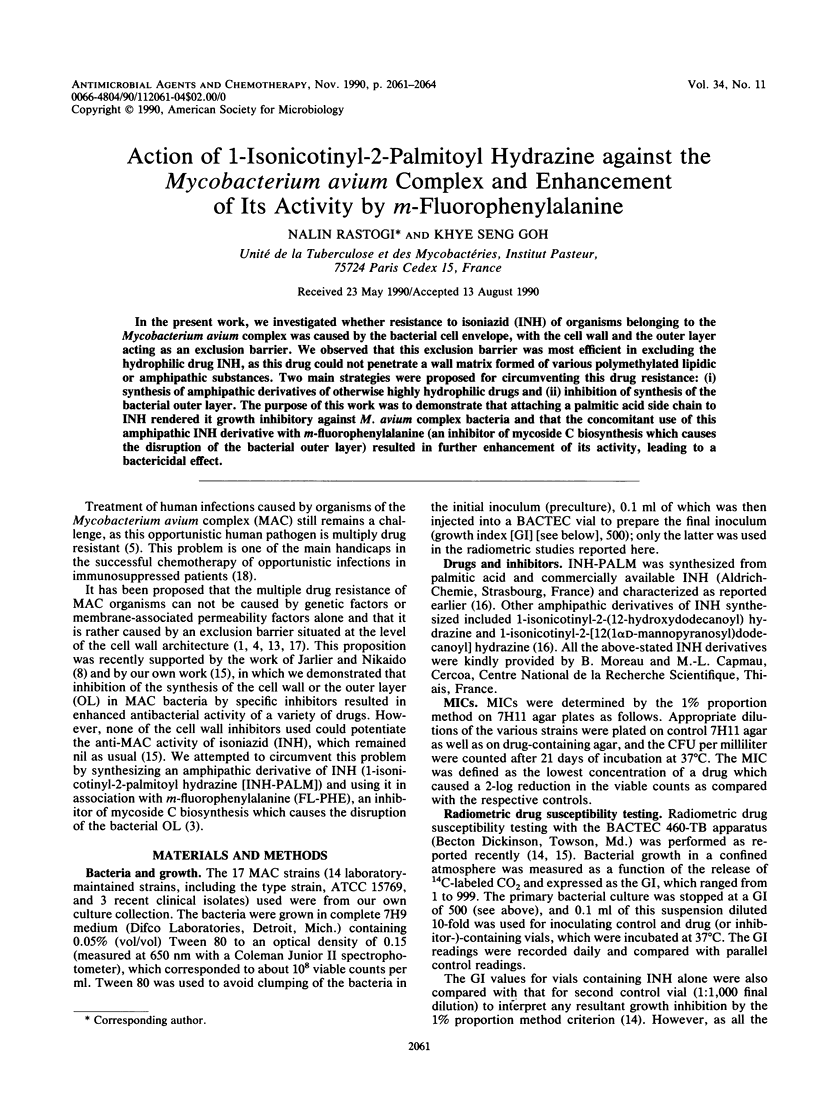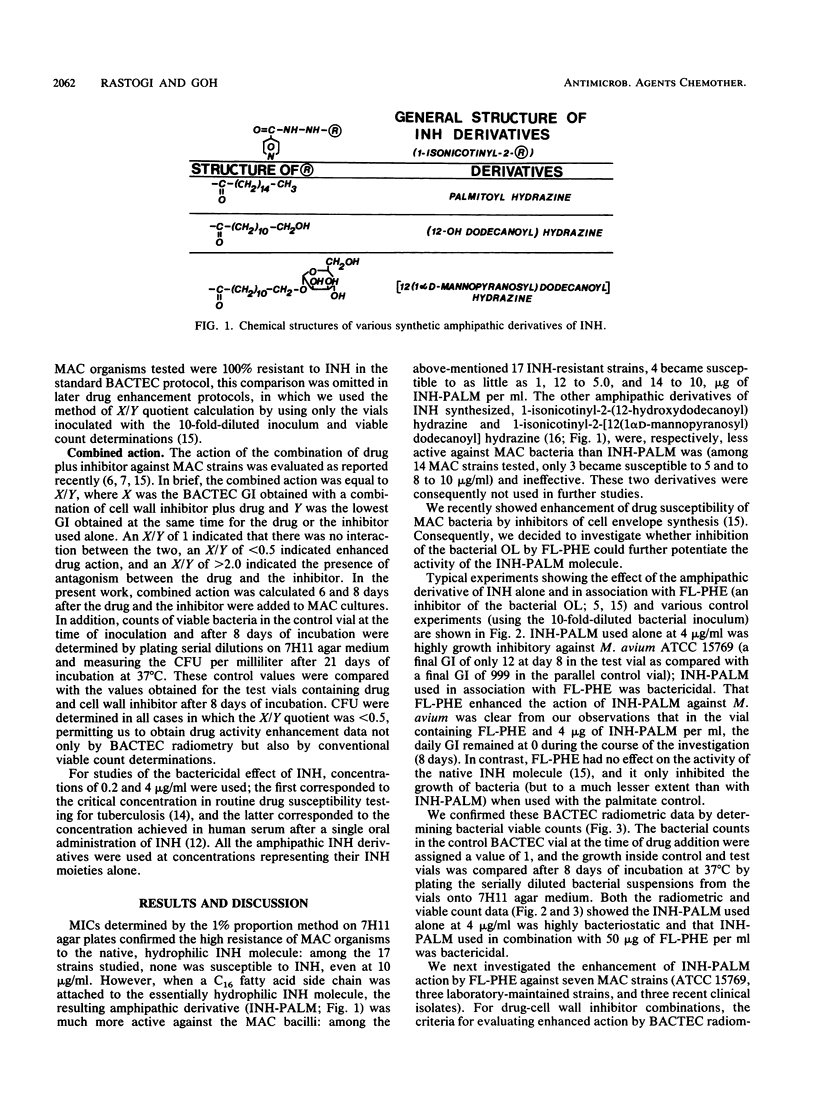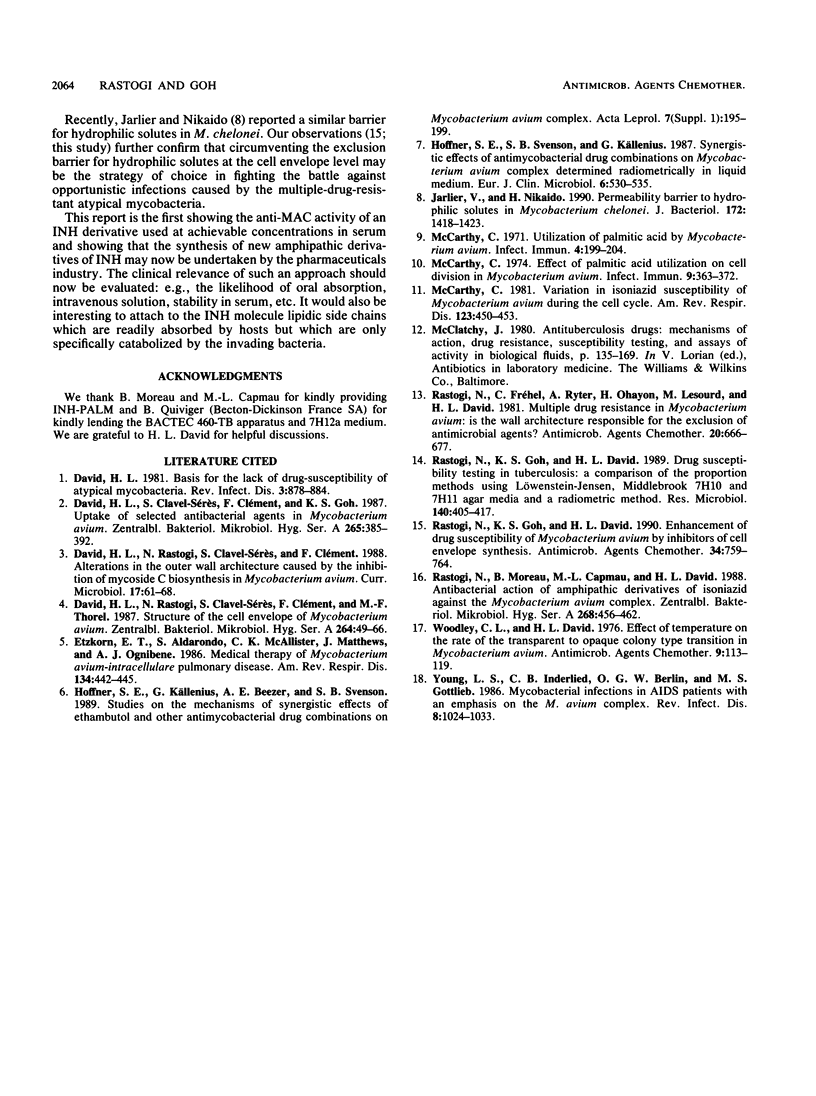Abstract
In the present work, we investigated whether resistance to isoniazid (INH) of organisms belonging to the Mycobacterium avium complex was caused by the bacterial cell envelope, with the cell wall and the outer layer acting as an exclusion barrier. We observed that this exclusion barrier was most efficient in excluding the hydrophilic drug INH, as this drug could not penetrate a wall matrix formed of various polymethylated lipidic or amphipathic substances. Two main strategies were proposed for circumventing this drug resistance: (i) synthesis of amphipathic derivatives of otherwise highly hydrophilic drugs and (ii) inhibition of synthesis of the bacterial outer layer. The purpose of this work was to demonstrate that attaching a palmitic acid side chain to INH rendered it growth inhibitory against M. avium complex bacteria and that the concomitant use of this amphipathic INH derivative with m-fluorophenylalanine (an inhibitor of mycoside C biosynthesis which causes the disruption of the bacterial outer layer) resulted in further enhancement of its activity, leading to a bactericidal effect.
Full text
PDF



Selected References
These references are in PubMed. This may not be the complete list of references from this article.
- David H. L. Basis for lack of drug susceptibility of atypical mycobacteria. Rev Infect Dis. 1981 Sep-Oct;3(5):878–884. doi: 10.1093/clinids/3.5.878. [DOI] [PubMed] [Google Scholar]
- David H. L., Clavel-Seres S., Clement F., Goh K. S. Uptake of selected antibacterial agents in Mycobacterium avium. Zentralbl Bakteriol Mikrobiol Hyg A. 1987 Jul;265(3-4):385–392. [PubMed] [Google Scholar]
- David H. L., Rastogi N., Clavel-Sérès S., Clément F., Thorel M. F. Structure of the cell envelope of Mycobacterium avium. Zentralbl Bakteriol Mikrobiol Hyg A. 1987 Apr;264(1-2):49–66. doi: 10.1016/s0176-6724(87)80124-4. [DOI] [PubMed] [Google Scholar]
- Etzkorn E. T., Aldarondo S., McAllister C. K., Matthews J., Ognibene A. J. Medical therapy of Mycobacterium avium-intracellulare pulmonary disease. Am Rev Respir Dis. 1986 Sep;134(3):442–445. doi: 10.1164/arrd.1986.134.3.442. [DOI] [PubMed] [Google Scholar]
- Hoffner S. E., Källenius G., Beezer A. E., Svenson S. B. Studies on the mechanisms of the synergistic effects of ethambutol and other antibacterial drugs on Mycobacterium avium complex. Acta Leprol. 1989;7 (Suppl 1):195–199. [PubMed] [Google Scholar]
- Hoffner S. E., Svenson S. B., Källenius G. Synergistic effects of antimycobacterial drug combinations on Mycobacterium avium complex determined radiometrically in liquid medium. Eur J Clin Microbiol. 1987 Oct;6(5):530–535. doi: 10.1007/BF02014241. [DOI] [PubMed] [Google Scholar]
- Jarlier V., Nikaido H. Permeability barrier to hydrophilic solutes in Mycobacterium chelonei. J Bacteriol. 1990 Mar;172(3):1418–1423. doi: 10.1128/jb.172.3.1418-1423.1990. [DOI] [PMC free article] [PubMed] [Google Scholar]
- McCarthy C. M. Variation in isoniazid susceptibility of Mycobacterium avium during the cell cycle. Am Rev Respir Dis. 1981 Apr;123(4 Pt 1):450–453. doi: 10.1164/arrd.1981.123.4.450. [DOI] [PubMed] [Google Scholar]
- McCarthy C. Effect of palmitic acid utilization on cell division in Mycobacterium avium. Infect Immun. 1974 Feb;9(2):363–372. doi: 10.1128/iai.9.2.363-372.1974. [DOI] [PMC free article] [PubMed] [Google Scholar]
- McCarthy C. Utilization of palmitic acid by Mycobacterium avium. Infect Immun. 1971 Sep;4(3):199–204. doi: 10.1128/iai.4.3.199-204.1971. [DOI] [PMC free article] [PubMed] [Google Scholar]
- Rastogi N., Frehel C., Ryter A., Ohayon H., Lesourd M., David H. L. Multiple drug resistance in Mycobacterium avium: is the wall architecture responsible for exclusion of antimicrobial agents? Antimicrob Agents Chemother. 1981 Nov;20(5):666–677. doi: 10.1128/aac.20.5.666. [DOI] [PMC free article] [PubMed] [Google Scholar]
- Rastogi N., Goh K. S., David H. L. Drug susceptibility testing in tuberculosis: a comparison of the proportion methods using Lowenstein-Jensen, Middlebrook 7H10 and 7H11 agar media and a radiometric method. Res Microbiol. 1989 Jul-Aug;140(6):405–417. doi: 10.1016/0923-2508(89)90016-8. [DOI] [PubMed] [Google Scholar]
- Rastogi N., Goh K. S., David H. L. Enhancement of drug susceptibility of Mycobacterium avium by inhibitors of cell envelope synthesis. Antimicrob Agents Chemother. 1990 May;34(5):759–764. doi: 10.1128/aac.34.5.759. [DOI] [PMC free article] [PubMed] [Google Scholar]
- Rastogi N., Moreau B., Capmau M. L., Goh K. S., David H. L. Antibacterial action of amphipathic derivatives of isoniazid against the Mycobacterium avium complex. Zentralbl Bakteriol Mikrobiol Hyg A. 1988 Jun;268(4):456–462. doi: 10.1016/s0176-6724(88)80123-8. [DOI] [PubMed] [Google Scholar]
- Woodley C. L., David H. L. Effect of temperature on the rate of the transparent to opaque colony type transition in Mycobacterium avium. Antimicrob Agents Chemother. 1976 Jan;9(1):113–119. doi: 10.1128/aac.9.1.113. [DOI] [PMC free article] [PubMed] [Google Scholar]
- Young L. S., Inderlied C. B., Berlin O. G., Gottlieb M. S. Mycobacterial infections in AIDS patients, with an emphasis on the Mycobacterium avium complex. Rev Infect Dis. 1986 Nov-Dec;8(6):1024–1033. doi: 10.1093/clinids/8.6.1024. [DOI] [PubMed] [Google Scholar]


